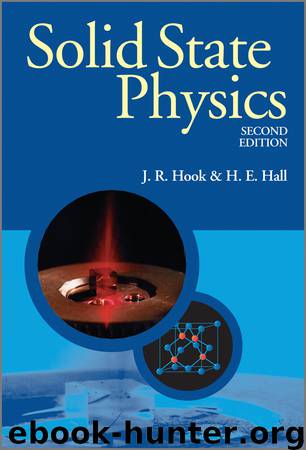Solid State Physics by Hook J. R. Hall H. E. & H. E. Hall

Author:Hook, J. R., Hall, H. E. & H. E. Hall [Hook, J. R., Hall, H. E. & Hall, H. E.]
Language: eng
Format: epub
Publisher: Wiley
Published: 2013-06-26T14:00:00+00:00
Fig. 8.7 Magnetization of an antiferromagnet in a direction perpendicular to the sublattice spontaneous magnetizations can be achieved by slight tilting of the atomic moments as shown
first order in the applied field at T = 0 where both sublattices are perfectly aligned. It is only near TN that the molecular field weakens and the two susceptibilities become comparable.
8.5 SPIN WAVES
8.5.1 Ferromagnets at low temperatures
The mean field theory of ferromagnetism fails at low temperatures because it does not predict correctly the low lying excited states. To see this consider the one-dimensional chain of ferromagnetically aligned spins shown in Fig. 8.8(a). If the spin at one end of the chain is rotated through 360°, then the other spins relax into the arrangement shown in Fig. 8.8(b) to minimize the exchange energy. This is a low lying excited state because neighbouring spins are very nearly parallel in the resulting structure so that very little exchange energy is lost. However the mean field theory attributes a very high energy to this state since the average magnetization and hence the molecular field vanish. The crucial point is that the energy of a spin should depend on the orientation of the other spins in its neighbourhood and not on the average magnetization of the sample.
Fig. 8.8 (b) Low lying excited state of the chain to which mean field theory incorrectly attributes a high energy. In real crystals crystalline anisotropy provides an ‘easy’ direction for the magnetization and the lowest lying excited states correspond to small departures of the spins from this preferred direction as in our spin wave calculation of section 8.5.2. Because of the crystalline anisotropy, the spin wave frequency tends to a finite value in the infinite-wavelength limit (see problem 8.6)
Download
This site does not store any files on its server. We only index and link to content provided by other sites. Please contact the content providers to delete copyright contents if any and email us, we'll remove relevant links or contents immediately.
The Complete Stick Figure Physics Tutorials by Allen Sarah(7336)
Secrets of Antigravity Propulsion: Tesla, UFOs, and Classified Aerospace Technology by Ph.D. Paul A. Laviolette(5332)
Thing Explainer by Randall Munroe(3909)
The River of Consciousness by Oliver Sacks(3572)
The Order of Time by Carlo Rovelli(3162)
How To by Randall Munroe(3074)
A Brief History of Time by Stephen Hawking(2991)
I Live in the Future & Here's How It Works by Nick Bilton(2960)
What If?: Serious Scientific Answers to Absurd Hypothetical Questions by Randall Munroe(2667)
The Great Unknown by Marcus du Sautoy(2662)
Midnight in Chernobyl by Adam Higginbotham(2515)
Blockchain: Ultimate Step By Step Guide To Understanding Blockchain Technology, Bitcoin Creation, and the future of Money (Novice to Expert) by Keizer Söze(2467)
Networks: An Introduction by Newman Mark(2382)
The Meaning of it All by Richard Feynman(2318)
Easy Electronics by Charles Platt(2308)
The Tao of Physics by Fritjof Capra(2247)
Midnight in Chernobyl: The Untold Story of the World's Greatest Nuclear Disaster by Adam Higginbotham(2195)
When by Daniel H Pink(2098)
Introducing Relativity by Bruce Bassett(2097)
